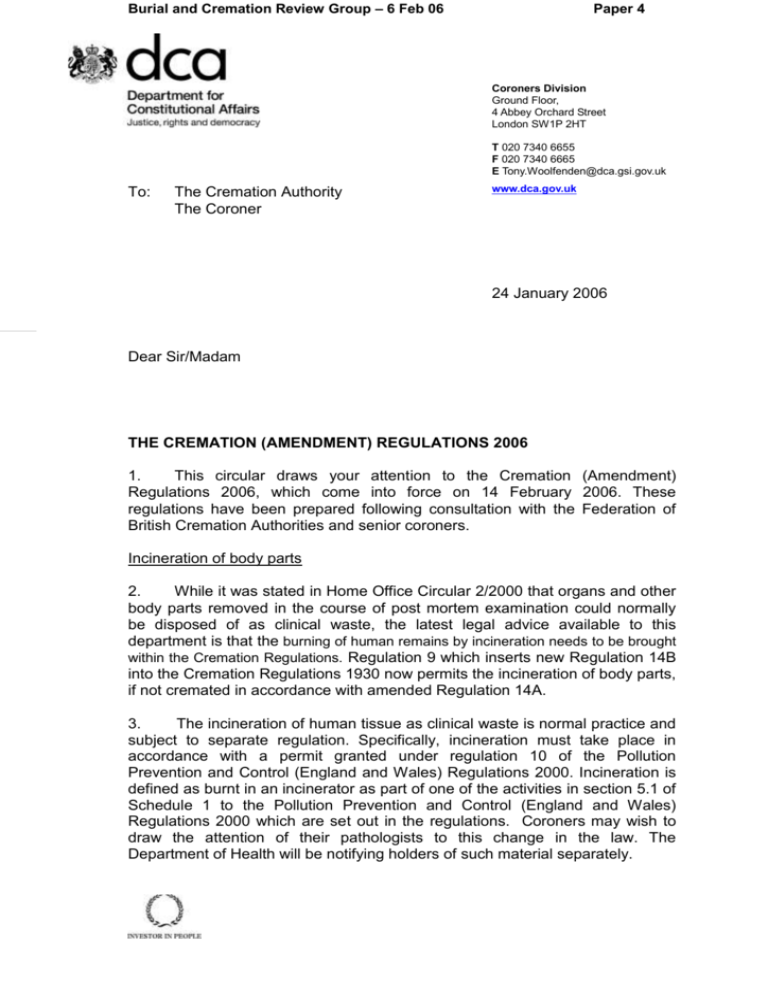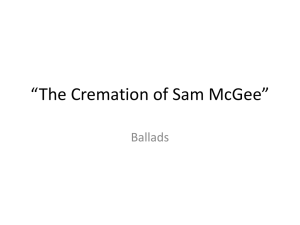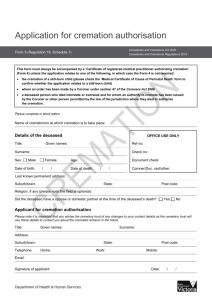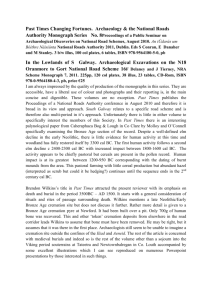Open
advertisement

Burial and Cremation Review Group – 6 Feb 06 Paper 4 Coroners Division Ground Floor, 4 Abbey Orchard Street London SW1P 2HT f T 020 7340 6655 F 020 7340 6665 E Tony.Woolfenden@dca.gsi.gov.uk To: The Cremation Authority The Coroner www.dca.gov.uk 24 January 2006 Dear Sir/Madam THE CREMATION (AMENDMENT) REGULATIONS 2006 1. This circular draws your attention to the Cremation (Amendment) Regulations 2006, which come into force on 14 February 2006. These regulations have been prepared following consultation with the Federation of British Cremation Authorities and senior coroners. Incineration of body parts 2. While it was stated in Home Office Circular 2/2000 that organs and other body parts removed in the course of post mortem examination could normally be disposed of as clinical waste, the latest legal advice available to this department is that the burning of human remains by incineration needs to be brought within the Cremation Regulations. Regulation 9 which inserts new Regulation 14B into the Cremation Regulations 1930 now permits the incineration of body parts, if not cremated in accordance with amended Regulation 14A. 3. The incineration of human tissue as clinical waste is normal practice and subject to separate regulation. Specifically, incineration must take place in accordance with a permit granted under regulation 10 of the Pollution Prevention and Control (England and Wales) Regulations 2000. Incineration is defined as burnt in an incinerator as part of one of the activities in section 5.1 of Schedule 1 to the Pollution Prevention and Control (England and Wales) Regulations 2000 which are set out in the regulations. Coroners may wish to draw the attention of their pathologists to this change in the law. The Department of Health will be notifying holders of such material separately. 4. Incineration of body parts is not a matter for a cremation authority. If, however, it is preferred that such body parts be cremated, there is no reason why such body parts cannot be cremated. provided there is full compliance with the relevant Cremation Regulations, in particular regulation 14A, as amended, In cases of doubt it will still be open to refer the case to the Secretary of State in accordance with regulation 14A(6). It should be noted that the body parts no longer have to be removed during a post-mortem examination; they may have been separated from the body before, during or after death, for example as a result of a violent incident. Body parts are now defined as also constituting a stillborn child. Cremation of bodies where the death occurred outside the British islands 5 With effect from 14 February 2006 these Regulations dispense with the requirement to obtain an authority in lieu of medical forms B and C from the Secretary of State in all cases where the death occurred outside the British Islands and where a body is to be cremated at a crematorium within England and Wales. Instead the coroner will now issue a Certificate E, even when the death is from natural causes. The coroner will need to determine in each case whether there is a need to order a post-mortem examination and to open an inquest. 6. The documentation returning with the body will need to be carefully examined and, if necessary, translations obtained. An original document giving the cause of death will often be crucial. In certain cases it will be helpful to discuss the circumstances with the deceased’s GP or other registered medical practitioner involved in the recent treatment of the deceased. It should be born in mind that the medical referee at the crematorium will be entitled to refuse to allow the cremation if the fact and cause of death has not been definitely ascertained, unless an inquest has been opened. It may therefore be helpful to insert the cause of death on the reverse of Form E. Stillborn children 7. Regulation 15 allows the medical referee to permit the cremation of the remains of a still-born child if it is certified to be still-born by a registered medical practitioner after examination of the body. We understand that medical practitioners do not always attend stillbirths and are not necessarily in a position to definitely ascertain the facts of the case. Following representations from the Royal College of Midwives it has been decided that registered midwives may also certify such remains as stillborn. Equivalent amendments apply to children stillborn outside England and Wales (See regulation 11 amending regulation 15A of the 1930 Regulations.) Civil Partnership Act 2004 8 The provisions of this Act are now in force and there is a need to make a number of consequential changes to the wording of the statutory forms, especially Form A, AA and G. Medical Referees Obliged to Give Reasons 9. It is no longer acceptable for a Medical Referee to refuse to issue a Form F without explanation and Regulation 6(3), amending Regulation 12(8) of the Cremation Regulations 1930, makes it necessary for a Referee to give reasons where he declines to allow a cremation. Births and Deaths Registration Act 1953 10. Regulations 3(d), 4 6(2) and 10(b) and (c) update references to the Births and Deaths Registration Act 1953 from the partly repealed 1926 Act. Enquiries 11. Any enquiries about the regulations or the contents of this circular should be addressed to Brian Patterson, Coroners Division, Department for Constitutional Affairs, Ground Floor, 4 Abbey Orchard Street. London SW1P 2HT ( 020 7340 6675; fax: 020 7340 6665; brian.patterson@dca.gsi.gov.uk ). 12. Unless sent electronically, copies of this circular and of the regulations are enclosed for the information of Medical and Deputy Medical Referees at all crematoria in England and Wales. Yours faithfully TONY WOOLFENDEN HEAD OF CORONERS DIVISION STATUTORY INSTRUMENTS 2006 No.92 CREMATION, ENGLAND AND WALES The Cremation (Amendment) Regulations 2006 Made - - - - Laid before Parliament Coming into force - 18th January 2006 23rd January 2006 - 14th February 2006 The Secretary of State makes the following Regulations in exercise of the powers conferred by section 7 of the Cremation Act 1902 (1): Citation, commencement and extent 1. These Regulations may be cited as the Cremation (Amendment) Regulations 2006 and come into force on 14th February 2006. 2. These Regulations extend to England and Wales only. Amendment to the Regulations as to Cremation (1930) 3. Amend the Regulations as to Cremation (1930)(2) as follows. 4.Amend the Definitions as follows— (a) for the definition of “Body Parts” substitute— ““Body parts” means material which consists of, or includes, human cells from— (a) a deceased person, whether or not separation from the body occurred before, after or during death; or (b) a stillborn child.”; (b) after the definition of “Cremation Authority” insert— ““incinerated” means burnt in an incinerator as part of one of the following activities in section 5.1 of Schedule 1 to the Pollution, Prevention and Control (England and Wales) Regulations 2000(3)— (a) activities in Part A(1)(a), (c), (d) and (e); (b) activities in Part A(2)(a); and (c) activities in Part B(a). “List of Wastes Regulations” means— (a) in relation to England, the List of Wastes (England) Regulations 2005(4); and (1) 1902 c.8 as amended by the Cremation Act 1952 c.31 section 2 and the Finance Act 1949 c.47 Schedule 11 Part V. (2) S.R. & O. 1930/1016 as amended by the Cremation (Amendment) Regulations 2000 S.I. 2000/58. (3) S.I. 2000/1973. Section 5.1 of Schedule 1 was substituted by S.I. 2002/2980 regulation 5(5)(a) and amended by S.I. 2004/3276 regulation 2(3)(h)(i). (b) in relation to Wales, the List of Wastes (Wales) Regulations 2005 (5).”; (c) after the definition of “Medical Referee” insert— ““permit” means a permit granted under regulation 10 of the Pollution Prevention and Control (England and Wales) Regulations 2000.”; and (d) omit the definition of “The Act of 1926”. 5. In regulation 6— (a) for “Section 2(2) of the Act of 1926” substitute “Section 24(2) of the Act of 1953”; and (b) for “Section 2(4) of the Act of 1926” substitute “Section 24(4) of the Act of 1953”. 6. In regulation 8 after (d) insert— “(dd) The death occurred outside the British Islands and the Coroner has certified on Form “E” that the death was by natural causes and no post-mortem examination or inquest is necessary; or”. 7.—(1) Amend regulation 12 as follows. (2) In paragraph (2)— (a) for “Section 2(1) of the Act of 1926” substitute “Section 24(1) of the Act of 1953”; (b) for “Section 2(2) of the Act of 1926” substitute “Section 24(2) of the Act of 1953”; and (c) for “Section 2(4) of the Act of 1926” substitute “Section 24(4) of the Act of 1953”. (3) In paragraph (8) for “without stating any reason” substitute “but must give reasons”. 8. In regulation 12A— (a) for paragraph 1(d) substitute— “(d) in the case of the remains of a person who has died in any place outside the British Islands, Form “E” issued by a coroner.”; and (b) Omit paragraph (2). 9.—(1) Amend Regulation 14A as follows. (2) For paragraph (1) substitute— “(1) The cremation of body parts can only take place in accordance with this regulation.”. (3) In paragraph (2)— (a) for sub-paragraph (a) substitute— “(a) by the production of a certificate in Form “DD”; or (aa) by production of evidence that the body parts were removed in the course of a postmortem examination carried out on the body of the deceased;”; (b) in sub-paragraph (b)— (i) after sub-paragraph (ii) insert— “or (iii) a certificate in pursuance of section 11 of the Act of 1953,”; and (ii) for “from whom the body parts have been removed” substitute “or stillbirth to which the body parts belonged”; and (c) in sub-paragraph (c) after “deceased” insert “or stillborn”. (4) In paragraph (3) after “death” insert “or stillbirth”. 10. After regulation 14A insert— “14B Body parts, which are not cremated in accordance with regulation 14A, may be incinerated in accordance with a permit which authorises the disposal of a matter listed in code 18 01 02 or 18 01 03 of the List of Wastes Regulations.”. (4) S.I. 2005/895 as amended by S.I 2005/1673. (5) S.I. 2005/1820. 11. In regulation 15— (a) after “registered medical practitioner” insert “or a registered midwife”; (b) for “Section 7(4) of the Act of 1926” substitute “Section 11(2) of the Act of 1953”; and (c) for “Section 2(4) of the Act of 1926” substitute “Section 11(3) of the Act of 1953”. 12. In regulation 15A— (a) after “registered medical practitioner” insert “or a registered midwife”; and (b) after “a medical practitioner” insert “or a midwife”. 13.—(1) Amend the Schedule as follows. (2) In Form “A” for “married, widow, widower, or unmarried” substitute “married, civil partner, widow, widower, surviving civil partner, neither married nor in a civil partnership”. (3) In Form “AA”— (a) for “married, widow, widower, or unmarried” substitute “married, civil partner, widow, widower, surviving civil partner, neither married nor in a civil partnership”; (b) omit “those body parts having been removed in the course of a post-mortem examination”; (c) for “or widower” substitute “, widower or surviving civil partner”; and (d) at the end insert “In the case of a stillborn child, in place of the name, address and occupation, insert a description sufficient to identify the body, and in place of the word “deceased” throughout insert the words “stillborn child”.”. (4) In Form “DD” for “organs were removed in the course of the post-mortem examination carried out on” substitute “body parts are held in respect of”. (5) In Form “E” after “*(b)” insert— “(c) I am satisfied that the death occurred outside the British Islands and that the death was by natural causes and no post-mortem examination or inquest is necessary.”. (6) In Form “G” for “married or unmarried” substitute “married, a civil partner, neither married nor in a civil partnership”. On the authority of the Secretary of State Date 18th January 2006 Harriet Harman Minster of State Department for Constitutional Affairs EXPLANATORY NOTE (This note is not part of the Regulations) This Regulation amends the Regulations as to Cremation 1930 (“the 1930 Regulations”) as made under section 7 of the Cremation Act 1902 (“the 1902 Act”). Regulation 4(a) amends the definition of “body parts” to extend its application to all parts of bodies from deceased persons. Previously, cremation of body parts in accordance with regulation 14A of the 1930 Regulations only allowed for the cremation of body parts removed during post mortem. This meant that parts severed from a body during the course of death or prior to death were not covered by the regulation. This change will allow cremation of parts of someone identified after the rest of the body has been buried e.g. where a body has been severely disrupted in a bomb blast. The definition has also been extended to include parts of a stillborn child. Regulations 4(b) and (c) and 10 authorise the incineration of body parts where an incinerator has a specific permit for that purpose. The 1902 Act is an Act to allow the regulation of the burning of human remains and the 1930 Regulations previously only legislated for the cremation of human remains (including body parts) in Crematoria. This amendment will bring into the ambit of the Regulations the incineration of body parts by hospitals and other such establishments in possession of parts of a deceased body, where the retention of that part of the body is no longer necessary and the families do not wish cremation or burial of the part. For example, tissue used for forensic testing. Regulations 4(d), 5, 7(2) and 11(b) and (c) are to update references to the Births and Deaths Registration Act 1953(6) from the repealed 1926 Act. Regulations 6, 8 and 13(5) are to allow coroners to deal with cases where a death has occurred outside the British Islands without the need for referral to the Secretary of State. Regulation 7(3) makes it necessary for a Medical Referee to give reasons where he declines to allow a cremation. Regulation 9(2) tidies up the former wording of Regulation 14A(1) of the 1930 Regulations and by removing the references to earlier Regulations it ensures that body parts of stillborn children are included. Regulations 9(3)(b) and (c), (4) and 13(3)(d) are to extend Regulation 14A of the 1930 Regulations to include the cremation of body parts of stillborn children. Regulations 9(3)(a) and (b)(ii), 13(3)(b) and 13(4) are to remove the restriction of the cremation of body parts applying only to body parts removed during a post mortem. Regulations 11(a) and 12 allow midwives, who often are the only medical person present at a delivery, to certify a stillbirth. Regulations 13(2), 3(a) and (c) and (6) are to ensure that the forms apply to civil partnerships in the same way as they apply to matrimonial relationships. (6) 1953 c.20.



